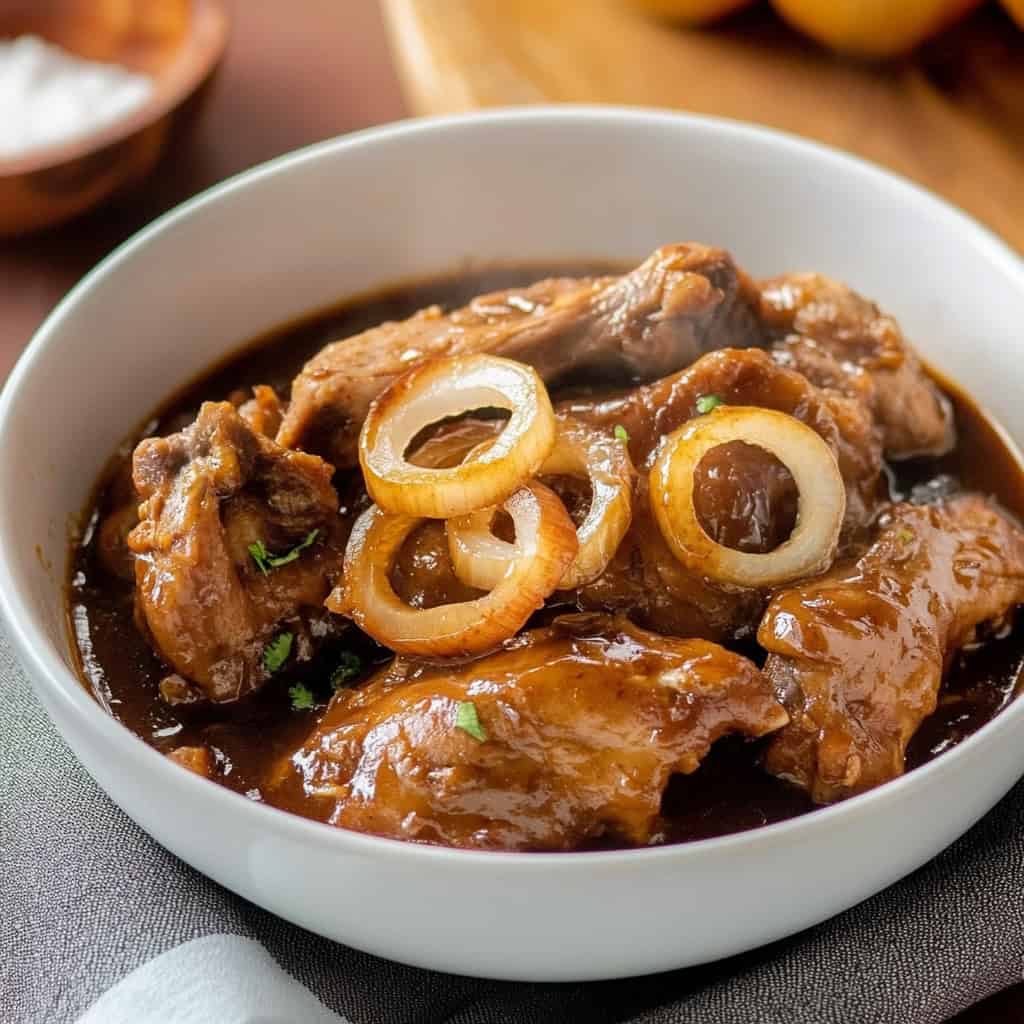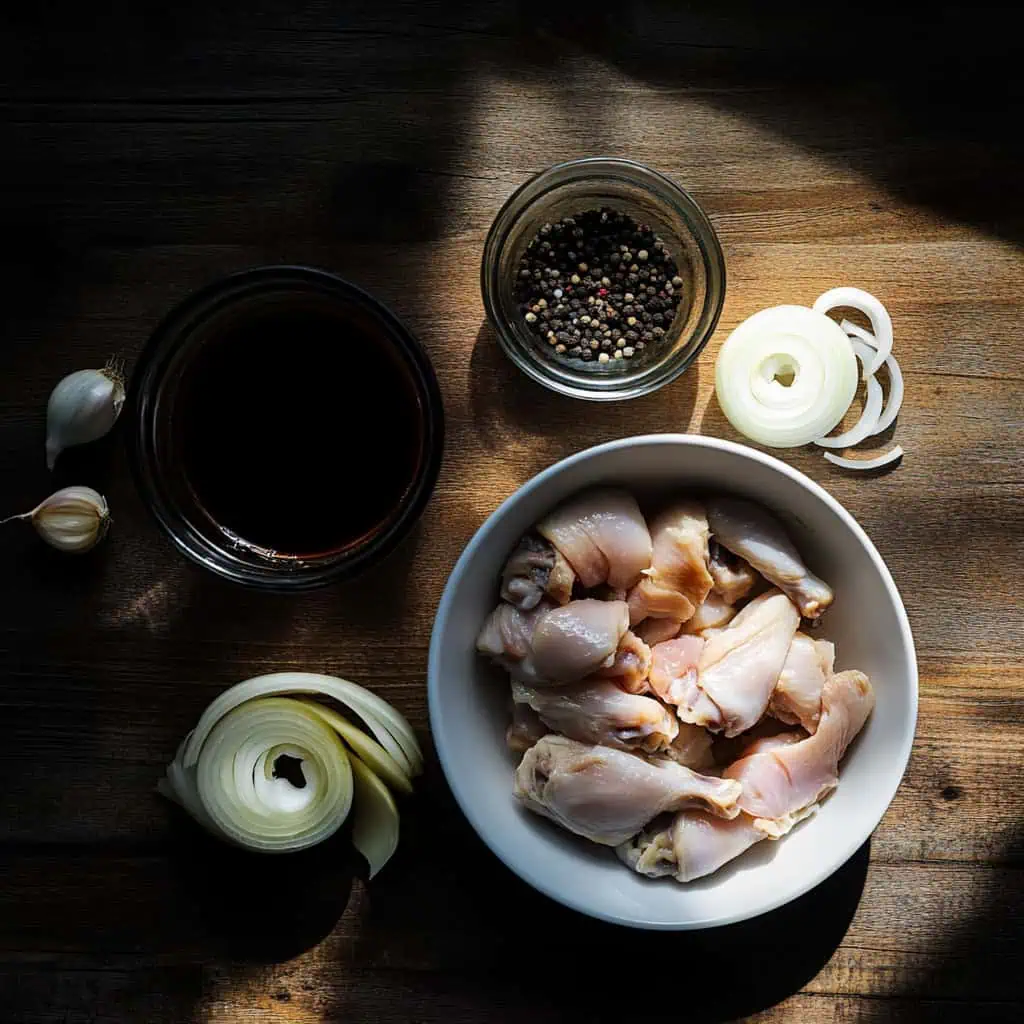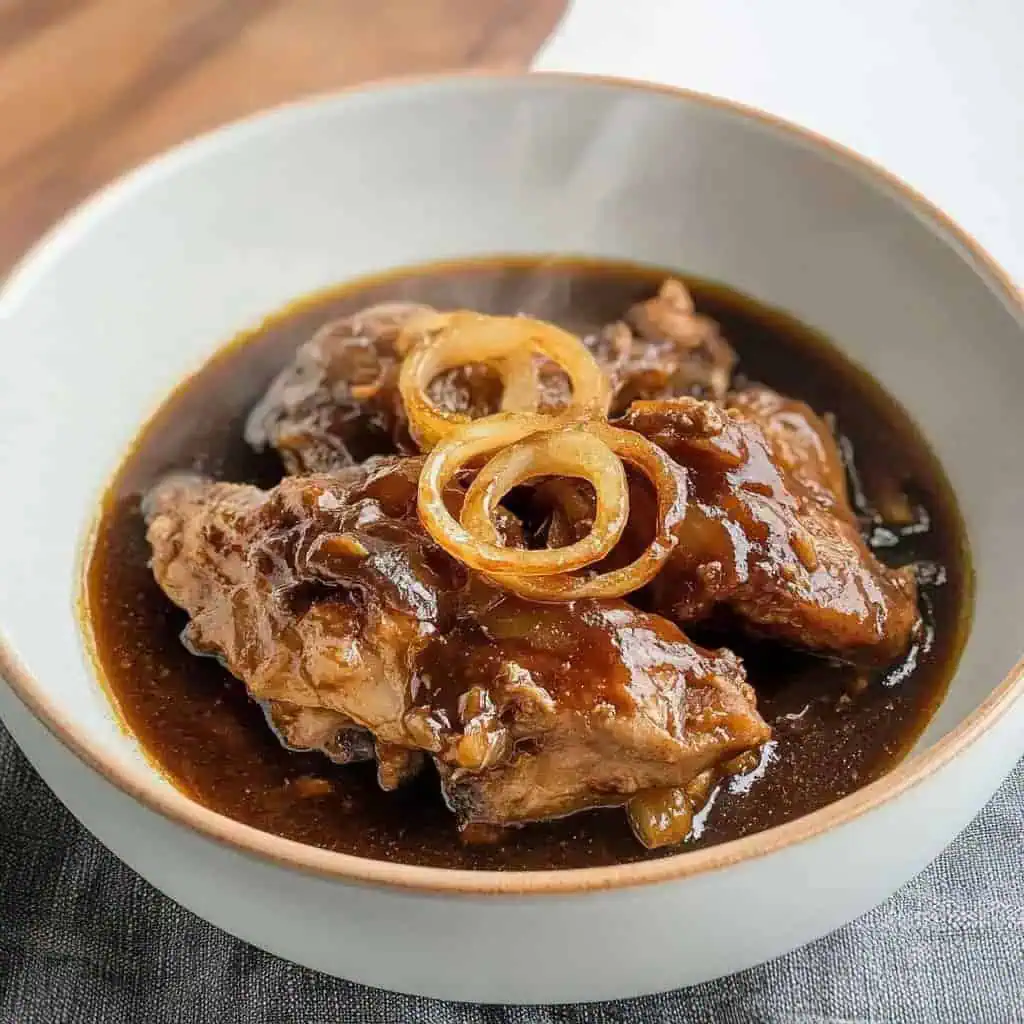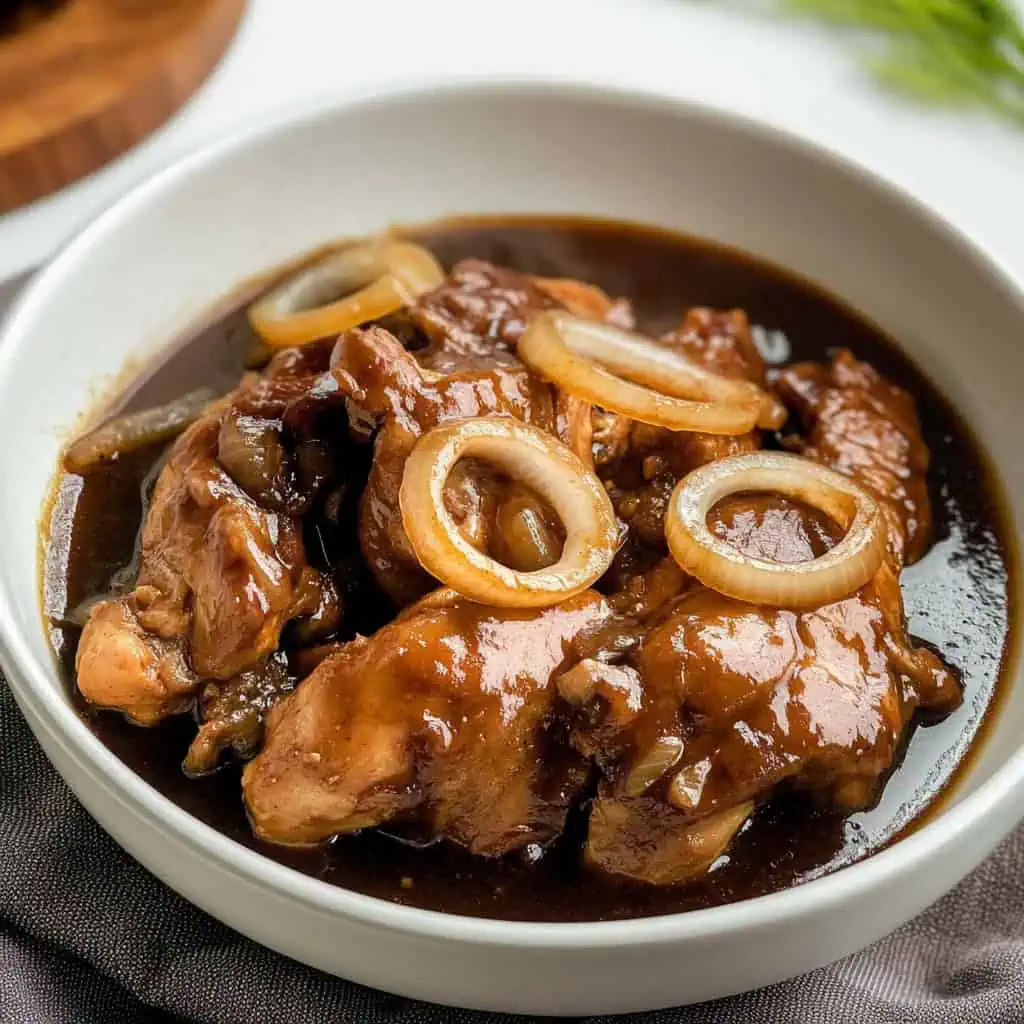I've always cherished how my father's face would light up during mealtimes. But when he was diagnosed with high blood pressure, I had to reimagine our family favorites – and that's how this Chicken Bistek became our ultimate comfort food.
By swapping the traditional beef for lean chicken and carefully balancing the toyo-calamansi marinade, I created a healthier version that still captures that classic bistek flavor we Pinoys can't resist.
The secret? I add a dollop of liver spread to thicken the sauce, just like how my Lola taught me, making it perfect for drizzling over hot rice (because let's be honest, that's the best part!).
I'm excited to share this recipe with you because it's not just another chicken dish, it's a testament to how Filipino cooking can adapt while keeping its soul.
Whether you're watching your budget (chicken is way more affordable than beef these days), cooking for someone special, or just craving that perfect balance of asim and alat, this Chicken Bistek recipe delivers all the flavors of your childhood with a modern, healthier twist.
Jump to:

Why You'll Love This Recipe
- Budget-friendly alternative to traditional beef bistek
- Ready in just over an hour (faster than beef version)
- Perfect balance of tangy calamansi and umami soy sauce
- Creates its own delicious sauce for rice
- One-pan meal for easy cleanup
- Versatile recipe that works with different chicken parts
- Family-friendly comfort food
- Authentic Filipino flavors made accessible
Ingredients
Each component in this recipe serves a specific purpose for authentic Filipino flavor. The calamansi provides the signature tangy "asim" while soy sauce delivers the savory "alat" foundation. Bone-in chicken parts release collagen during cooking, creating a richer sauce than lean cuts would.
Garlic and peppercorns add depth, while onions contribute sweetness that balances the acidity. The liver spread is our secret weapon – it thickens the sauce while adding a subtle richness that brings everything together without overpowering the dish.

- 3 pounds chicken legs, thighs, or whole chicken cut into serving pieces
- ¼ cup calamansi juice (or lemon juice)
- ¼ cup soy sauce
- 4 cloves garlic, minced
- ½ teaspoon whole black peppercorns, slightly crushed
- 2 large onions, sliced into rings (1 for cooking, 1 for garnish)
- 1 tablespoon canola oil
- 1 cup water
- 2 tablespoons liver spread (Reno or similar)
- Salt to taste
- Green onions for garnish (optional)
Equipment
- Large non-reactive bowl - For marinating chicken without chemical reactions that could affect flavor
- Heavy-bottom skillet or kawali (12-inch) - Ensures even heat distribution and prevents burning
- Tongs - For easily turning chicken pieces without piercing the meat
- Sharp knife - Essential for uniform cutting to ensure even cooking
- Measuring cups and spoons - For precise ingredient measurements
- Wooden spoon - Won't scratch your pan and is perfect for stirring the sauce
- Kitchen timer - Helps track cooking times for perfectly tender chicken

How To Make
- Prepare your ingredients and equipment. Gather everything you'll need before starting.
- Create the marinade. In a large non-reactive bowl, combine calamansi juice, soy sauce, minced garlic, and crushed black peppercorns. Mix well.
- Marinate the chicken. Add chicken pieces to the marinade and massage it into the meat. Cover and refrigerate for 30-60 minutes (not longer, as the acid can break down the meat too much).
- Prepare for cooking. After marinating, remove the chicken from the marinade but SAVE the liquid with the garlic and spices. Pat the chicken pieces dry with paper towels.
- Brown the chicken. Heat oil in your heavy-bottom pan over medium heat. Once hot, add the chicken pieces and reserved garlic from the marinade. Cook until golden brown on all sides, about 5-7 minutes per side.
- Simmer to tenderness. Pour the reserved marinade and water into the pan. Bring to a boil, then lower the heat, cover, and simmer for 20-25 minutes or until the chicken is tender.
- Enrich the sauce. Add liver spread to the pan and stir until completely dissolved. Simmer uncovered for another 3-5 minutes until the sauce thickens nicely. Taste and add salt if needed.
- Rest before serving. Turn off the heat and let the dish rest for 5 minutes. This allows the flavors to settle and the meat to reabsorb some juices.
- Serve with love. Transfer to a serving dish, garnish with fresh onion rings, and serve hot with steamed rice. For extra tang, serve with calamansi halves on the side.

Tips from Lola's Kitchen
- Use bone-in chicken pieces for more flavor and moisture - the bones add richness to the sauce
- Don't skip the liver spread - it's truly the secret ingredient that transforms the sauce from good to exceptional
- Choose chicken pieces of similar size to ensure even cooking throughout
- For crispier skin, pat the chicken very dry before browning and ensure your oil is properly heated
- Let the chicken rest for 5-10 minutes before serving to allow juices to redistribute
- Add a bay leaf during simmering for an additional layer of complexity
- For deeper flavor, use dark soy sauce for half of the soy sauce amount
- Allow enough reduction time - don't rush the final simmering stage where the sauce develops its character
Substitutions
- No calamansi? Use 3 tablespoons lemon juice + 1 tablespoon lime juice for a similar flavor profile
- Out of liver spread? Substitute with 1 tablespoon liver pâté or 1 tablespoon oyster sauce mixed with ½ teaspoon sugar
- Canola oil alternatives: Any neutral cooking oil works well (avocado, grapeseed, or vegetable oil)
- Fresh garlic substitute: Use 2 teaspoons garlic powder, but add it directly to the marinade
- Chicken options: Boneless thighs work great (reduce cooking time by 5-10 minutes), but avoid breast meat unless you're very careful not to overcook
- Soy sauce alternatives: Coconut aminos or tamari (for gluten-free option)
- Low sodium version: Use low-sodium soy sauce and add a pinch of mushroom powder for umami
Troubleshooting
Sauce too thin?
- Simmer uncovered for 5-7 more minutes to reduce
- Add 1 more tablespoon liver spread
- Mix ½ teaspoon cornstarch with 1 tablespoon water and stir into simmering sauce
Chicken not browning properly?
- Ensure chicken is well-drained and thoroughly patted dry
- Your pan may not be hot enough - increase heat slightly
- Don't overcrowd the pan - cook in batches if necessary
- Use a heavy-bottomed pan that retains heat well
Sauce too salty?
- Add a squeeze of fresh calamansi or lemon juice to balance
- Add ¼ cup water and reduce again
- Add a small pinch of sugar to counterbalance saltiness
Chicken too tough?
- Lower heat and cook longer with lid on
- Add ¼ cup more water if sauce is reducing too quickly
- Use a meat thermometer to check for doneness (165°F/74°C)
- Choose dark meat (thighs, legs) rather than breast for more forgiving cooking
Sauce splitting or looks curdled?
- Lower heat immediately
- Whisk vigorously while adding 1-2 tablespoons of hot water
- In future, ensure acid (calamansi) is added during marination only, not to hot liquid
Storage & Reheating
Refrigerator Storage:
- Store in an airtight container for up to 3 days
- Actually improves in flavor overnight as the spices meld
Freezer Storage:
- Cool completely before transferring to freezer-safe containers
- Store for up to 3 months
- Label with date and contents
- Leave some space for expansion when freezing
Reheating Methods:
Stovetop (Best Method):
- Place in a pan with 2 tablespoons of water
- Cover and heat on medium-low, stirring occasionally
- Heat until internal temperature reaches 165°F
- If sauce has thickened too much, add a splash of water or chicken broth
Microwave:
- Place in a microwave-safe container with a splash of water
- Cover loosely (leave vent)
- Heat at 70% power in 2-minute intervals, stirring between
- Check temperature before serving
Oven:
- Preheat to 325°F
- Place in an oven-safe dish covered with foil
- Heat for 15-20 minutes or until thoroughly heated
- Remove foil for the last 5 minutes to revive some crispness

FAQ
Can I use chicken breast instead of thighs or legs?
Yes, but watch the cooking time carefully. Reduce simmering to 15 minutes and check frequently, as breast meat dries out faster than dark meat. For best results, use bone-in, skin-on breasts.
Is liver spread absolutely necessary?
While not mandatory, liver spread adds significant richness and helps thicken the sauce. Without it, you'll need to simmer the sauce longer to reduce and intensify flavors. Alternatives include oyster sauce with a touch of sugar or reduced beef broth.
Can I make this dish ahead for a party?
Absolutely! This dish actually tastes better the next day as flavors develop. Reheat gently on the stovetop with a splash of water to prevent drying out.
Why did my sauce curdle?
This typically happens if acid (calamansi) is added to hot liquid. Always add acidic ingredients during the marination stage or when the dish has cooled slightly.
Can I double the recipe for a larger gathering?
Yes, but brown the chicken in batches to ensure proper caramelization. Use a larger pan for the simmering stage or divide between two pans.
How can I make this dish spicy?
Add 2-3 Thai chilies or siling labuyo during the simmering stage, or serve with fresh chilies on the side for guests to add according to their preference.
Can I use this same recipe with other meats?
Absolutely! Try it with pork tenderloin (25-30 minutes cooking time) or beef chuck cut into thin strips (45-60 minutes cooking time).
Is this dish gluten-free?
Not in its traditional form due to the soy sauce. Substitute with tamari or coconut aminos for a gluten-free version.
What's the best way to slice onions for this dish?
For cooking, medium thickness (about ¼ inch) works best as they'll break down during simmering. For garnish, slice them thinner for a crisp, fresh contrast.
How do I know when the chicken is perfectly cooked?
The safest method is using a meat thermometer (165°F/74°C). Without one, pierce the thickest part of the chicken - the juices should run clear with no pinkness, and the meat should pull easily from the bone.
Related
Looking for other recipes like this? Try these:

Filipino Chicken Bistek (Bistek Manok)
Equipment
- Large non-reactive bowl for marinating
- Heavy-bottom skillet or kawali (12-inch) ensures even heating and prevents burning
- Tongs [Sipit] for easy turning of chicken pieces
- Sharp knife (matalim na kutsilyo) for uniform cutting
- Measuring cups and spoons (Panukat) for precise ingredients measurement
- Wooden spoon (sandok na kahoy) won't scratch your pan
- Kitchen Timer
Ingredients
For the Chicken Marinade:
- 3 pounds chicken legs, thighs, or whole chicken cut into serving pieces
- ¼ cup calamansi juice katas ng kalamansi or lemon juice
- ¼ cup soy sauce toyo
- 4 cloves garlic bawang, minced
- ½ teaspoon whole black peppercorns paminta, slightly crushed
- 1 large onion sibuyas, sliced into rings
For Cooking:
- 1 tablespoon canola oil
- 1 cup water
- 2 tablespoons liver spread Reno or similar
- Salt asin to taste
For Garnish:
- 1 large onion sliced into rings
- Green onions optional
Instructions
- First, gather all your ingredients and kitchen tools. You'll need a large bowl for marinating and a wide pan or kawali for cooking.
- In a bowl, combine ¼ cup calamansi juice, ¼ cup soy sauce, 4 cloves minced garlic, and ½ teaspoon crushed black peppercorns. Add your chicken pieces and massage the marinade into the meat. Cover and let it marinate in the refrigerator for 30-60 minutes.
- After marinating, remove the chicken from the marinade but don't throw the liquid away - save it along with the garlic and spices. Pat the chicken pieces dry with paper towels.
- Heat 1 tablespoon oil in your pan over medium heat. Once hot, add the chicken pieces and the reserved garlic from the marinade. Cook until the chicken turns golden brown on all sides, about 5-7 minutes per side.
- Pour the reserved marinade and 1 cup of water into the pan. Let it come to a boil, then lower the heat, cover the pan, and let it simmer for 20-25 minutes or until the chicken is tender.
- Add 2 tablespoons of liver spread to the pan and stir until it completely dissolves into the sauce. Let it simmer uncovered for another 3-5 minutes until the sauce thickens nicely. Taste and add salt if needed.
- Turn off the heat and let the dish rest for 5 minutes. Transfer to a serving dish, garnish with fresh onion rings, and serve hot with steamed rice. For extra flavor, serve with calamansi halves on the side.
- Remember: Don't marinate longer than 1 hour as the acid in calamansi can make the meat too soft, and always make sure your chicken is cooked through before serving.
Tips from Lola's Kitchen
- Use bone-in chicken pieces for more flavor
- Don't skip the liver spread - it's the secret to a rich sauce
- Marinate chicken pieces with similar sizes for even cooking
- For crispier skin, pat chicken very dry before browning
- Let chicken rest 5-10 minutes before serving
- For extra flavor, add 1 bay leaf (dahon ng laurel) while simmering
Nutrition
The Story Behind Filipino Chicken Bistek
Like many beloved Filipino dishes, Bistek (or Bistik) traces its roots to Spanish colonial times, evolving from the Spanish "Bistec Encebollado" - a dish of beef steak smothered in onions. When Spanish colonizers brought this cooking technique to Philippine shores in the 16th century, resourceful Filipino cooks transformed it using local ingredients, most notably replacing the wine vinegar with calamansi juice and incorporating our beloved soy sauce for that distinctly Asian umami.
While traditional Bistek Tagalog typically features beef, the rising cost of meat in post-war Philippines led innovative home cooks to experiment with more affordable proteins. This gave birth to variations like our Chicken Bistek (Bistek Manok), which quickly became a staple in Filipino households. The chicken version wasn't just economical - it also offered a lighter alternative that was perfect for everyday meals, while still maintaining that signature tangy-savory profile that Filipinos love.
What makes Filipino Bistek unique from its Spanish ancestor is its distinctive marinade of calamansi and soy sauce, creating that perfect balance of asim at alat (sour and salty) that's quintessentially Filipino. In this chicken version, the addition of liver spread - a post-war influence that gained popularity in Filipino cooking - adds richness and body to the sauce that's absolutely irresistible when spooned over hot rice. This modern adaptation proves how Filipino cuisine continues to evolve while honoring its historical roots.
Today, Chicken Bistek has earned its place alongside classic Bistek Tagalog in Filipino cuisine. You'll find it everywhere from humble carinderia stalls to modern Filipino restaurants, each adding their own twist while maintaining those core flavors that make it unmistakably Filipino. Whether served at family dinners, packed for lunch, or featured at celebrations, this dish represents the Filipino talent for adapting foreign influences into something uniquely our own - practical, flavorful, and perfectly suited to our tastes and way of life.










Comments
No Comments